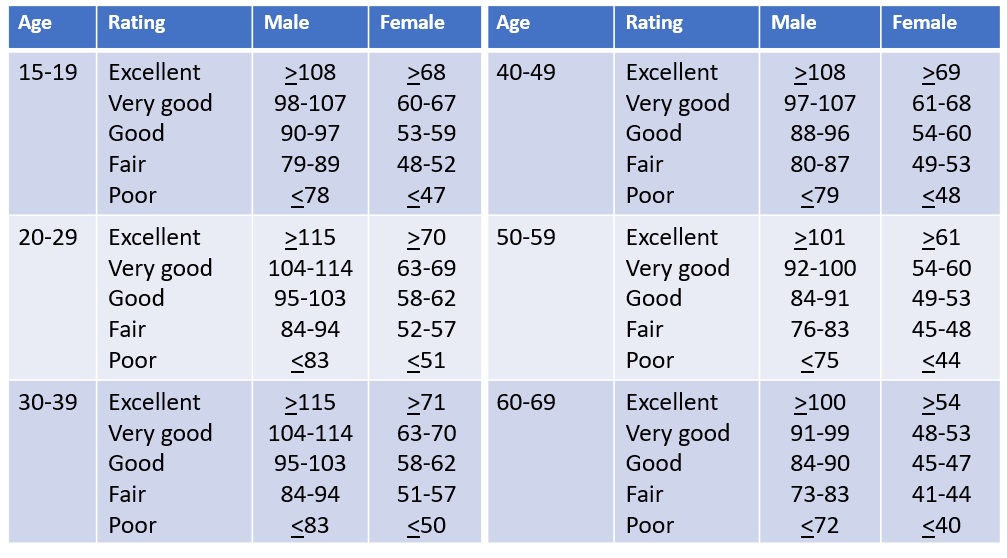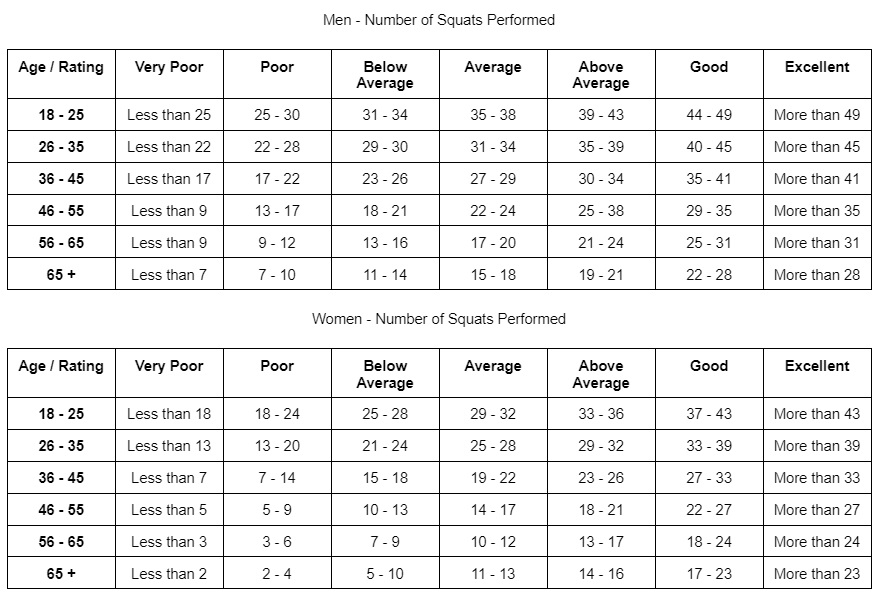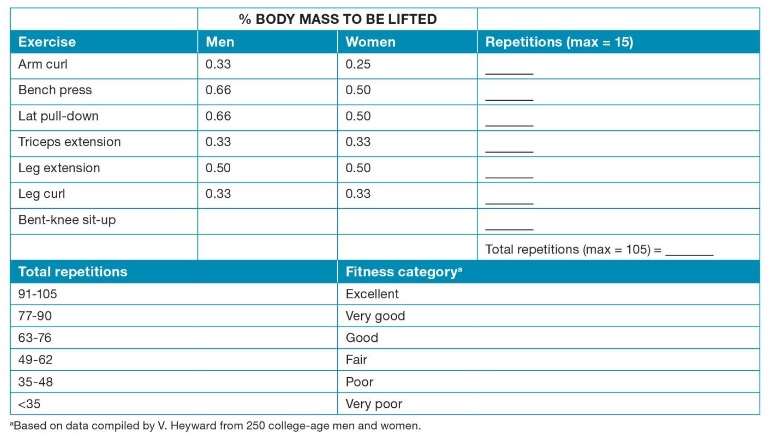Chapter 13 – Fitness and Stress Assessments
Muscular Strength and Endurance Assessment
Martin Dubuc
Muscular Strength is typically defined as the maximum amount of force a muscle (or muscles) can generate in a single contraction (i.e., 1 Repetition Maximum or 1-RM), while Muscular Endurance tends to reflect a muscle’s (or muscles’) ability to provide multiple repetitions or remain contracted for an extended period of time. Our muscles’ ability to generate force or endure repeated strain extends beyond their size and is in fact, a reflection of a combination of factors. As is discussed in Chapter 5 of this textbook, our muscles are composed of various muscle fiber types that differ in their characteristics and capacities, which will impact how much force or endurance they provide. Other factors, such as the nervous systems’ ability to recruit large amounts of muscle fibers, synchronize their firing, or the resistance of connective tissues to the strain they are placed under, all play important roles in determining an individual’s muscular strength and endurance. The following activities will help you assess your current level of muscular strength and endurance, as well as track your improvements as you progress through the program.
Activity 2.1 – Dynamic Muscular Strength Battery
The following six exercises are often used as a test battery (i.e., a series of tests/exercises) to determine someone’s overall dynamic muscular strength (i.e., strength through a range of motion where changes in muscle fibre length takes place). Note – the Grip Strength test described further in this unit is an example of isometric muscular strength since there is no range of motion or change in muscle fibre length. Given that attempting actual 1-RMs poses a significant injury risk, particularly when proper form is not adhered to, this activity requires predicting your 1-RM for the six exercises provided by producing a larger number of reps. It stands to reason that larger individuals tend to generate more strength (absolute strength), which is why strength is often expressed in relative terms (weight lifted by body weight) in order to compare your performance to established norms. For example, rather than stating “the average college-age male can bench press 200lbs” norms have been established that determine “the average college-age mal can bench press their body weight. If you happen to weigh more, it is expected you would be able to bench press more weight as well. This allows us to compare individuals of various sizes against established norms, as you will be expected to do for this lab activity.
Procedure
After completing a thorough warm-up, including lifting light to moderate weights of the exercises in question, choose a weight with which you believe you can only achieve five to ten repetitions. If you cannot do five, the prediction equation will still work. However, if you complete more than ten repetitions, give yourself several minutes of recovery and try again with a heavier weight. You will need to record the weight lifted and the amount of repetitions for the following exercises:
- Bench Press (barbell – flat bench)
- Arm Curl (barbell)
- Lat Pull Down
- Leg Press
- Leg Extension
- Leg Curl
Calculations
Step 1: Use the following table, established by Baechle, Earle, and Wathen (2000), to see what percentage of 1-RM you lifted based on the number of repetitions. There is an example below the table for you to see how to complete the calculation required for all six exercises.

Example Calculation
If you managed to lift a weight of 125 lbs for five repetitions, it estimates you were only lifting 87% of your 1-RM. To predict your 1-RM, simply divide the weight lifted by the estimated percentage:
125lbs / 0.87 = 143.7lbs (or rounded to 148lbs)
Step 2: Establish your Strength-to-body-mass ratio by dividing your newly estimated 1-RM from Step 1 for all six exercises by your body mass. DO NOT divide the weight you actually lifted; since you were able to do multiple repetitions, this is not your 1-RM.
Example Calculation
If you weigh 175lbs, and had a predicted 1-RM of 148lbs (from the example above), you would calculation your Strength-to-body mass ratio as follows:
148lbs (weight lifted) / 175 lbs (body mass) = 0.85 (only 2 decimals needed)
Step 3: Use the provided table below, developed by testing 250 college-age men and women, to see how many points your ratios give you for all six exercises. If your ratio is between two scores, use the lower score provided to determine how many points you’ve earned. Once you have added up your points for all six exercises, refer to the Total Points/Strength Fitness Category at the bottom of the table to determine your rating. There is an example below the table.

Example
If the ratio of 0.85 from Step 2 was during the Lat Pull Down (a male student who weighs 175lbs completed five repetitions of 125lbs of a Lat Pull Down), then that ratio has a value of three points (as seen in the right-most column). Note that if a female student achieved the same ratio, she would earn 10 points. Be careful that you are looking at the proper column for the exercise in question and the correct half (Men or Women) for the appropriate points.
Activity 2.2 – Grip Strength
The grip strength test uses a hand-grip dynamometer to measure the isometric muscular strength (i.e, no change in range of motion or muscle fibre length) generated by the hand and forearm in kilograms (kg) of force. It is often used as an indicator of total body strength.
To perform the test, place the grip of the dynamometer between the fingers and palm (at the base of the thumb). The second joint of the fingers should fit snugly under the handle and can be adjusted as needed. Hold the dynamometer next to your thigh with the dial facing out and do not let it touch your body. When you are ready, squeeze the dynamometer as hard as you can for a few seconds (maximal force) while exhaling throughout the contraction. It should remain relatively still throughout the contraction and not move around or touch the body. Measure each hand twice and add up the best trial (i.e., highest kg rating) of each hand, then refer to the table below for your Fitness Rating.

Activity 2.3 – Muscular Endurance Battery
For this activity, you will be completing three muscular endurance tests and providing your results and ratings for each.
Forearm Plank Test
This test is a measure of the muscular endurance of a variety of muscle groups, including abdominals (transverse abdominis, internal and external obliques, rectus abdominis), postural muscles that stabilize the spine, hips, pelvis, lower limbs, as well as shoulders and arms. The standardized technique for this test is for you to lie prone on a mat/floor with your elbows touching the ground. Your upper arms should be lined up directly beneath your shoulders, and your forearms should be in a neutral position with hands in front of the elbows. Your feet should be close together but not touching each other.
To perform the test, once you have positioned yourself in the form above, raise your pelvis off the ground and start a stopwatch. It is imperative that you establish and maintain a straight spine and rigid body position with only your forearms and toes making contact with the mat/floor. Once you cannot maintain the proper position (you can use a partner to observe and give a maximum of two warnings), the test is terminated, and the stopwatch is stopped. Use your time in seconds and refer to the table below to establish your percentile. You can round to the closest value for your time, and use whichever status (Varsity or Non-Varsity) you most identify with.

Push-Up Test
This test is a measure of muscular endurance of the chest, shoulders, and arms and requires you to perform as many repetitions as possible (with no time limit) without taking breaks, straining forcibly, or the ability to maintain proper technique. Since push-ups can vary in form, this test employs “military push-ups”, meaning the legs are together, hands are positioned under the shoulders with fingers pointed forwards, and the arms stay tucked near the side. Your chin must touch the ground for the repetition to count, so a thin mat or towel can be used to provide a softer surface. In order to use the comparative standards of the table below, men will be performing standard push-ups (with toes as a contact point), and women will be performing modified push-ups (with knees as a contact point).

Squat Endurance Test
This test is a measure of the muscular endurance of your lower limbs, particularly focusing on your quadriceps, glutes, and hamstrings. To perform this test, position yourself in an athletic stance (i.e., your feet slightly wider than shoulder width with toes faintly pointing out), with your hands on your hips or on opposite shoulders, and a neutral spine (i.e., head and back straight). Your weight should be over the arches of the feet or slightly towards the heels. When you are ready, squat down while maintaining the aforementioned form until your thighs are at 90 degrees (or parallel to the floor), then rise back up to the starting position (this is one repetition). Complete as many squats as you can without stopping, then use this number to refer to your rating in the table below.

Activity 2.4 – Dynamic Muscle Endurance Battery
The following seven exercises are often used as a test battery (i.e., a series of tests/exercises) to determine someone’s overall dynamic muscular endurance. As with the Muscular Strength tests described previously, the term dynamic implies repetitions through a range of motion and changes in muscle fibre length (e.g., Push-ups, Squats), as opposed to isometric muscular endurance tests where the position is stationary and there is little change in fibre length (e.g., Plank Test).
As was seen in the Dynamic Muscular Strength Battery, the weight used in these exercises will be determined by a ratio relative to your body weight (see Activity 2.1 for a description of absolute vs relative). It is worth noting the seventh exercise (the Bent-Knee Sit-Ups) is bodyweight only.
Procedure
After completing a thorough warm-up, including light weights of the exercises in question, calculate the required weight to be lifted based on your biological gender and body weight for the seven exercises by referring to the table below. Once you have the correct weights, you will simply need to count the number of repetitions completed for each exercise, ensuring you do not complete more than 15 repetitions per exercise. An example demonstrating how to calculate the weight to be lifted is provided after the table.

Example Calculation
If I am a female student who weighs 125lbs, I will be required to lift 25% of my body weight (0.25) for the Arm Curl exercise. To calculate that weight, multiply the body mass by the percentage to be lifted:
125lbs x 0.25 = 31.3lbs (you can round up or down as needed based on equipment)
I would then be required to Arm Curl 31lbs for as many repetitions as possible in a single set, without exceeding 15 repetitions.
Calculating Rating:
Follow the example calculation above for the required exercises, counting your repetitions for each. Once each exercise is complete, add up the sum of all your repetitions and refer to the bottom of the table to find your Fitness Rating.
Reflection Questions
A. Based on the completion of Activity 2.1 – Dynamic Muscular Strength Battery, answer the following:
-
- Which of the six exercises gave you the lowest points, and which gave you the highest?
- Is this the result you were expecting? Justify your answer.
- Are you satisfied with your Total Points and Strength Fitness Rating? Based on your response, how do you plan on improving or maintaining your current result?
B. Based on the completion of Activity 2.2 – Grip Strength, answer the following:
-
- What was the difference in kilograms (kg) between your left and right hands (use the best trial of each to compare). If it is significantly different (more than 5kg), how would you try to even them out?
- What was your Grip Strength Rating according to the table? Is this the result you were expecting?
- Given how important Grip Strength is for the Stair Chair test, how do you plan on improving or maintaining your result?
C. Based on the completion of Activity 2.3 – Muscular Endurance Battery, answer the following:
-
- Which of the exercises gave you the lowest rating, and which gave you the highest? Are these also the exercises that felt the hardest and easiest, respectively?
- Is this the result you were expecting? Justify your answer.
- Are you satisfied with your Ratings for these three exercises? Based on your response, how do you plan on improving or maintaining your current result?
D. Based on the completion of Activity 2.1 – Dynamic Muscular Strength Battery, answer the following:
-
- Which of the seven exercises did you perform the least repetitions?
- Is this the result you were expecting? Justify your answer.
- Are you satisfied with your Total Repetitions and associated Fitness Rating? Based on your response, how do you plan on improving or maintaining your current result?

